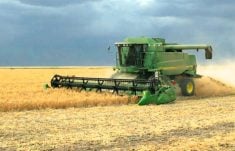BUENOS AIRES (Reuters) — Argentina’s recently planted wheat fields need more rains to ensure good yields, observers said, at a time of high global demand and dwindling stocks at home.
“If we don’t get rains in the next two to three weeks we will start worrying about yields,” said David Hughes, who manages 7,000 hectares of farmland in northern Buenos Aires province.
He said recent frosts in Argentina have so far not posed a threat to crops, but dryness is becoming a worry.
The South American grains powerhouse is a global wheat exporter with most of its shipments going to neighbouring Brazil, where import demand is growing after its own wheat crop has been hurt by frosts.
Read Also

Arlene Dickinson says recent trip to Asia opened her eyes to new trade opportunities
Arlene Dickinson says Canada must take up decades-old suggestions to support the agriculture and food sectors
A shortfall in Argentina’s crop could exacerbate global supply tensions and fuel the country’s already high inflation rate ahead of October’s mid-term congressional elections.
Argentina’s 2013-14 wheat harvest is expected to total 12 million tonnes, up from 10 million tonnes in the 2012-13 crop year, according to the U.S. Department of Agriculture.
Argentine fields need showers to moisten the budding plants that have begun carpeting the country’s vast Pampas grains belt, but growers have been disappointed by the weather over recent days.
“Rain in the wheat belt amounted to very little or nothing over the weekend,” said Anthony Deane, head of consultancy Weather-Wise Argentina.
He said four weather systems are expected to hit the belt — centred in Buenos Aires province — in September, the final two of which may provide substantial rainfall.
“The area should get 50 to 60 millimeters of rain this month, which would be enough to get wheat plants into their second stage of development and ensure yields,” Dean added. “Of course we will not know for sure until the end of the month.”
Spring, usually accompanied by rainstorms, starts in Argentina on Sept. 21.
“We are fervently awaiting the spring rains,” wheat farmer Juan Camio of the southern Buenos Aires town of Benito Juarez told La Nacion newspaper. The combination of dry, cold weather could, if it continues, hold back crop development, he said.
Global wheat supplies have been short after poor harvests last year in Russia, Australia and the United States. Usually a big exporter, Argentina was left wanting for wheat this year due to a miscalculation by the government in setting export limits.
The limits, applied to ensure ample domestic food supplies, backfired this year as the government approved too much wheat for export based on optimistic crop estimates. Little remains at this point to be milled into flour for bread.
Argentina’s wheat shortage has exacerbated the country’s inflation rate, clocked by private analysts at over 20 percent, prompting the government to freeze basic food prices ahead of October’s mid-term congressional election.
President Cristina Fernandez’s protectionist trade policies, currency controls and heavy-handed regulation of the grains sector have the government facing criticism over the management of Latin America’s No. 3 economy.














